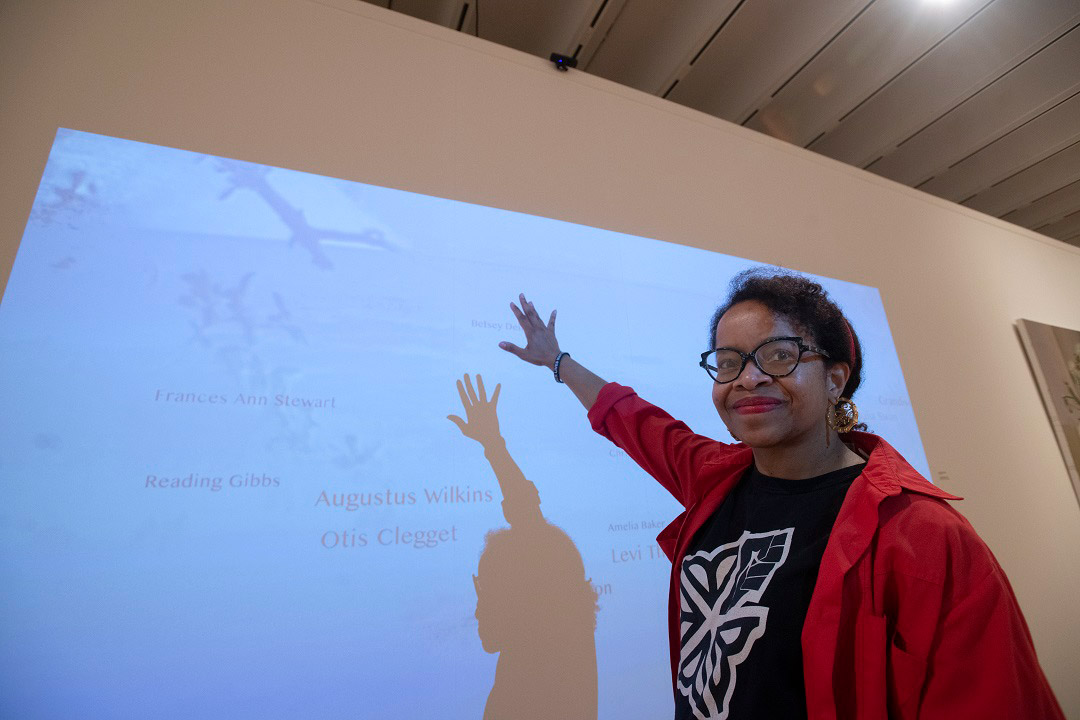Variety of RIT artists chosen for Rochester-Finger Lakes Exhibition at Memorial Art Gallery
Professor creates interactive memorial to Black people of Rochester’s past; among 28 members of the RIT community selected for exhibition
A. Sue Weisler
W. Michelle Harris, associate professor in RIT’s School of Interactive Games and Media, is one of 28 members of the RIT community who had pieces selected for the 67th Rochester-Finger Lakes Exhibition at the Memorial Art Gallery.
W. Michelle Harris, an associate professor in RIT’s School of Interactive Games and Media, enjoys starting conversations through art and interactive pixelcraft. That’s why she created In Their Wake, an interactive digital memorial to the forgotten Black people who developed Rochester.
This fall, her art was selected for the 67th Rochester-Finger Lakes Exhibition, the region’s longest-running juried exhibition. In fact, Harris is one of 28 members of the RIT community who had pieces selected for the exhibition, which runs through Oct. 17 at the Memorial Art Gallery (MAG).
The exhibition showcases new work in all media by emerging and established artists from 27 counties in western and central New York.
At first, In Their Wake appears to be a video projection of a large turquoise painting. But, as spectators walk by, a camera tracks their movement and the fog begins to clear and reveal the tides of Lake Ontario and the names of hundreds of Black people who lived in Rochester before the end of the Civil War.
W. Michelle Harris
In the piece In Their Wake, a camera tracks spectators' movement, and the fog begins to clear and reveal the tides of Lake Ontario and the names of hundreds of Black people who lived in Rochester before the end of the Civil War.
“Black people were present in Rochester during these times,” said Harris. “Some as servants or enslaved members of white settler households, some had escaped from elsewhere to find a fraction of freedom, and some worked on the Underground Railroad helping others escape to the endpoint at Lake Ontario.”
“Today there are only faint echoes of their presence in the land and water, but we exist in their wake,” Harris said. “I wanted to create a direct connection between the people then and the people now.”
The idea started when Harris read articles about rediscovered black graveyards in her Virginia hometown. She wanted to find ways to remember the first Black people who lived in Rochester, N.Y., prior to the Emancipation Proclamation. She was inspired by the book In The Wake: On Blackness and Being.
Harris wasn’t going to find these names on Ancestry.com, so she made her way to the Central Library of Rochester. There, she worked with staff to find public records from the establishment of the city. These segregated directories held the names, occupations, ages, and other information about a few hundred Black people living in Rochester.
The professor said that students in the new media interactive development courses she teaches—and other majors at RIT—can mix their technical and creative skills to develop unique experiences like this. Harris will discuss her creative process as part of a featured Artist Talk held 6-8 p.m. Oct. 7 at the MAG.
Other members of the RIT community selected for the 67th Rochester-Finger Lakes Exhibition include:
- Athesia Benjamin ’01 (painting), ’07 MFA (fine arts studio)
- Abigail Benkovich, a metal and jewelry design master’s student, who won the $500 Louis D’Amanda Memorial Award for It is Well, 2020
- Chad Cleveland ’05 MST (visual arts—all grades), ’09 MFA (fine arts studio)
- Bob Conge ’62 (art and design)
- Aaron Delehanty, adjunct faculty in the College of Art and Design (CAD)
- Roger Demuth ’70 (illustration)
- (David) Dan DeVona ’76 (art and design)
- Lukas Easton, former ceramics adjunct faculty/staff
- Unique Fair-Smith ’19 (illustration), ’21 MFA (fine arts studio)
- Jordan Funk, a photography and related media student
- Emily Glass, senior lecturer in the School of Art, who won the $500 Harris Popular Vote Award, given to the artist whose work receives the most votes from visitors during the first two weeks of the exhibition, for her work The Grand Old Dandelions.
- Rachael Gootnick ’09 MS (print and graphic media science)
- John Griebsch ’67 (photography)
- Stephen Harkola ’78 (new media marketing)
- Michael Harris ’73 (art and design)
- Cecelia Hayes ’07 (illustration)
- Thomas Insalaco ’70 (art and design), who won the $1,000 Alice E. Koret/Docent Award for Origins #6, 2021
- Alex Jarus, a furniture design master’s student
- Shayna Kiblin ’20 (photographic and imaging arts), a fine arts studio master’s student
- Eric Kunsman ’99 (professional photographic illustration), ’00 (biomedical photographic communication), a senior lecturer in NTID’s Department of Visual Communications Studies
- Nick Marshall ’10 (photographic and imaging arts)
- Portas ’09 (fine arts studio), ’11 MFA (fine arts studio)
- Edgar Praus ’76 MFA (professional photographic illustration)
- Beverly Rafferty ’04 (fine arts studio)
- Patricia Russotti, associate professor in CAD, won the $600 Ida Louis Abrams Award for Mycology_01, 2020
- Fabiano Sarra ’13 (furniture design), ’19 MFA (furniture design), instructional support specialist—fabrication processes in CAD
- Todd Stahl ’02 MST (visual arts—all grades).

